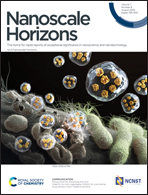A true color palette: binary metastable photonic pigments†
Abstract
Different from the traditional concept that binary photonic crystals can only reproduce mixed colors due to the simple superposition of the photonic band gaps, precisely addressable “true colors” obtained from volume fraction deviation of binary photonic crystals with metastable structures are reported here. Inspired by the mussels’ adhesion and longhorn beetles’ photonic scales, a binary metastable amorphous photonic crystal was obtained by enhancing the driving forces and customizing the surface roughness of building blocks to regulate the thermodynamic and dynamic factors simultaneously. By controlling the volume fraction of two building blocks, the tunable photonic bandgap varies linearly in the visible region. Furthermore, the “true violet” that cannot be obtained by conventional color mixing is reproduced with the particular ultraviolet characteristics of red photonic pigment's metastable structures, which complement the palette effect of “true colors”. Meanwhile, due to the self-adhesion and post-modification of building blocks, the stability of photonic pigments is further improved. The binary photonic pigments not only solve the dilemma of mixed colors, but also realize the tunability and multiplicity of “true colors”, offering a new choice for the color palette of the world.



 Please wait while we load your content...
Please wait while we load your content...